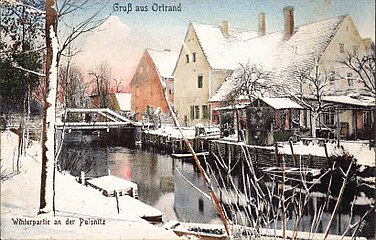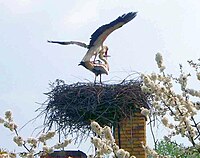Hauptvogel dye works (Ortrand)
The former Hauptvogel dye works is a listed building in the small town of Ortrand in southern Brandenburg . The property is located in the north of the historic old town of Ortrand directly on the Pulsnitz . The main building was dated to the beginning of the 17th century by the Brandenburg State Office for Monument Protection, making it one of the oldest houses in the city near the Saxon border. It is recorded in the local monument register under registration number 09120320.
Building description
The house is a two-story building with a gable roof . While the upper floor was built as a half-timbered building, the lower floor is solid and faced with clinker bricks. The roof has a simple plain tile covering (spall covering). The Brandenburg State Office for Monument Preservation dates the construction of the house to the beginning of the 17th century, whereby the oldest beam made of pine wood was felled in 1602 according to a dendrological report from the Brandenburg State Office for Monument Preservation from 2000 . The most recent beam used to build the roof structure dates from 1611.
In the west of the main building, a single-storey extension is added, which was also provided with a gable roof.
The building address changed over time due to various changes in the urban infrastructure and renaming of the adjacent street. The property was initially at Lindenauer Thor 254 . In the 19th century it became Lindenauer Vorstadt 173 , later Lindenauer Straße 23 . In the present it is the street of the unit 23 .
history
The former Ortrander city archivist Heinz Lehmann speculated in an article on the history of the house published in the Ortrander Anzeiger in 1997 that it was built in the 16th century . Originally the Ortrander Stadtbaderei was located here. This was still in front of the Lindenauer Torhaus , one of the two city gates , and thus the fortifications of the city. As can be seen in the sales contracts, until at least the middle of the 19th century, hereditary interest had to be paid to the Ortrander city treasury on the bathroom . It is very likely that the house fell victim to a devastating city fire on March 20, 1612 before the Thirty Years' War , which also spread to the neighboring village of Burkersdorf via the Pulsnitz and, in addition to Burkersdorf with around 60 houses, half of the city, the school, the parish church and destroyed the Lindenau suburb . The timber that was felled in 1611 according to the appraisal of the State Monuments Office was probably used to rebuild the baths after the fire.
The property changed hands several times over the centuries. On May 16, 1671, Ursula Stelznerin, the widow of the bather and surgeon Johann George Stelzner, sold the house, including an adjoining garden, a meadow, various copper bowls and other accessories as an inheritance to the bather Johann Fluhrer for 350 Meißnian guilders . In 1772 it belonged to the bathers Friedrich Wilhelm Marx, who at that time also had the right to distill brandy. In 1827 it was owned by Johanna Christiane Marrin. She was the widow of the Ortrander city judge. It was followed in the next few years by Christian Salz Faktor, Friedrich Piersig and Leberecht Limbach, who had acquired the property in June 1833 for 1080 thalers.
From 1872, the Hauptvogel family finally appears in the property files, although they were already based in Ortrand before that. On June 30 of that year, the Ortrander butcher Johann Gottlieb Leberecht Limbach sold the Schönfärber Carl Heinrich Moritz Hauptvogel († 1918) his house and garden plot Lindenau suburban number 173/254 for 1,500 dollars. He soon set up a dye works in his buildings, which he bequeathed to his son Friedrich Emil Carl Hauptvogel (1875–1953). In addition to the dyeing, there was also a dry cleaning service and, to the delight of the Ortrander residents, a boat rental service on the Pulsnitz, which is also reflected in some contemporary postcards.
The dye works was given up in 1953. In that year, the then owner Friedrich Emil Karl Hauptvogel died and the property passed into the possession of his son Otto Hauptvogel († 1990).
The historic building of the former dye works is now in great need of renovation and, according to an expert opinion, the renovation in accordance with the requirements of the monument would cost 1.035 million euros. After Otto Hauptvogel's death in 1990, his widow Walli Hauptvogel became the owner of the house. When she also died in 2002, a few years later the descendants waived the inherited property by means of dereliction due to the expected high renovation costs .
The Ortrander white storks
There is a stork's nest above a chimney on the extension of the building. The nesting aid was set up here in 1992 by Klaus Hauptvogel. As far as is known, there was an eyrie on a poplar in Ortrand in 1934 (the year of the first international stork census), which was flown over the years but never incubated. According to the brochure "The White Stork in the Senftenberg District" published in 2005 by the regional white stork representative Werner Blaschke, the nesting aid above the old dye works was immediately accepted by a pair of white storks and that year a successful brood ensued with a young animal that had flown out. In the following year, three young white storks left the nest. According to Blaschke statistics, a total of 30 young storks left this nest by 2005, with the brood being most successful in 2001 and 2004 with four young animals each. The eyrie has not been incubated since 2007 (as of 2017). Other nesting aids available in the city near a school and on a factory chimney have never been incubated (as of 2004).
Media, publications and literature (selection)
- Heinz Lehmann: "Ortrand's oldest house and its owners" in Ortrander Stadtanzeiger , July 23, 1997.
- Second German television (ZDF) : "Mr. Hauptvogel's antenna" in turntable Germany , June 17, 2013.
- Kathleen Weser: "Reluctant minus millionaire claims his rights" in Lausitzer Rundschau , March 1, 2016.
- Rundfunk Berlin-Brandenburg : " House sale with obstacles" in Brandenburg aktuell , March 8, 2016, 7:30 pm.
- Judith Lembke: "When abandoned houses become a problem" in Frankfurter Allgemeine Zeitung , October 26, 2017.
Web links
Notes and individual references
- ↑ a b c d database of the Brandenburg State Office for the Preservation of Monuments and the State Archaeological Museum ( Memento of the original from December 9, 2017 in the Internet Archive ) Info: The archive link was automatically inserted and not yet checked. Please check the original and archive link according to the instructions and then remove this notice. , accessed January 20, 2018.
- ↑ a b c d Judith Lembke: "When abandoned houses become a problem" in Frankfurter Allgemeine Zeitung , October 26, 2017.
- ↑ a b c Kathleen Weser: “Reluctant minus millionaire demands his rights” in Lausitzer Rundschau , March 1, 2016.
- ^ Dendrological report by the Brandenburg State Office for Monument Preservation in Waldstadt from June 16, 2000.
- ↑ a b c d e f Heinz Lehmann: “Oldest house in Ortrand and its owners” in Ortrander Stadtanzeiger , July 23, 1997.
- ↑ a b Copy of the purchase contract in the Ortrander city archive between the widow Stelznerin and the journeyman Fluhrer from May 16, 1671 in the Hauptvogel private archive, Ortrand.
- ↑ Luise Grundmann, Dietrich Hanspach (author): Der Schraden. A regional study in the Elsterwerda, Lauchhammer, Hirschfeld and Ortrand area . Ed .: Institute for Regional Geography Leipzig and the Saxon Academy of Sciences in Leipzig. Böhlau Verlag, Cologne / Weimar / Vienna 2005, ISBN 3-412-10900-2 , p. 244 to 252 .
- ↑ Christian Heinrich Schreyer: Chronicle of the city Ortrand . tape 1 . Haffner, Großenhain 1852. ( digitized version )
- ^ Purchase contract between Friedrich Piersig and Leberecht Limbach dated June 8, 1833 in the Hauptvogel private archive, Ortrand.
- ↑ "Grandfather poked the boat" in Märkischer Bote , December 4, 2015.
- ↑ Heinz Menzel: The white stork in the Senftenberg district . tape 1 . Lohsa 1991, p. 57 .
- ↑ Werner Blaschke: The white stork in the Senftenberg district . tape 2 . Lauchhammer, Ruhland 2004, p. 18 .
Coordinates: 51 ° 22 ′ 40.1 ″ N , 13 ° 45 ′ 26.7 ″ E







